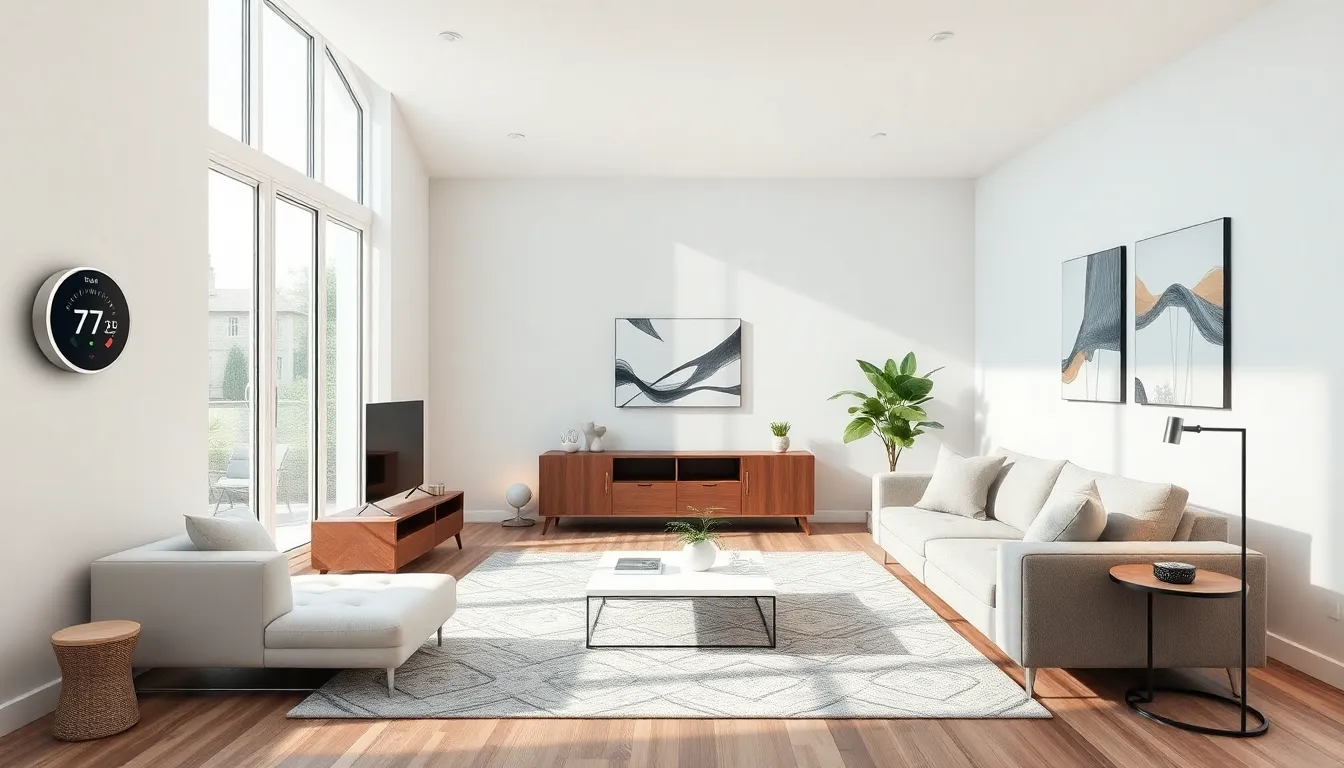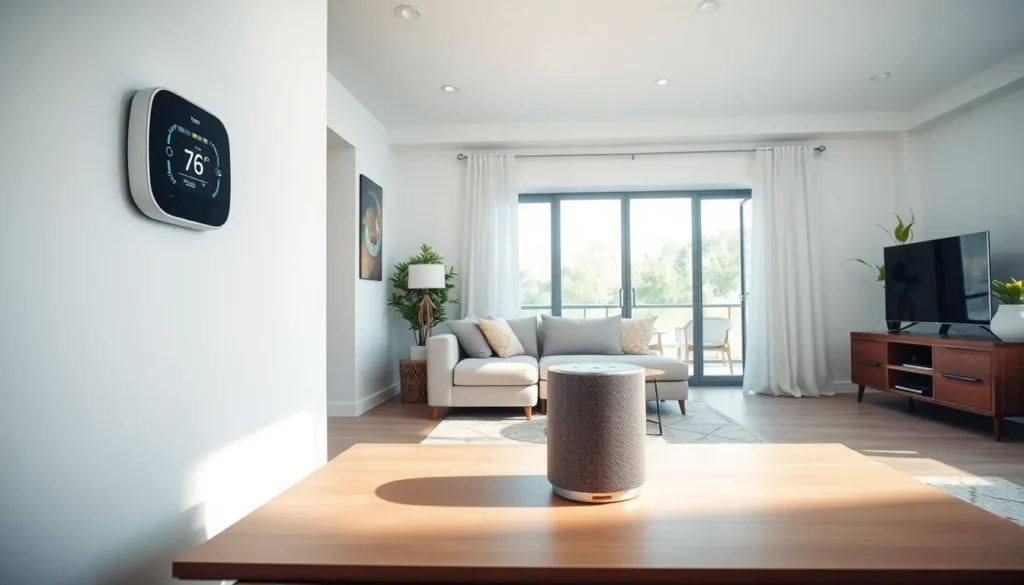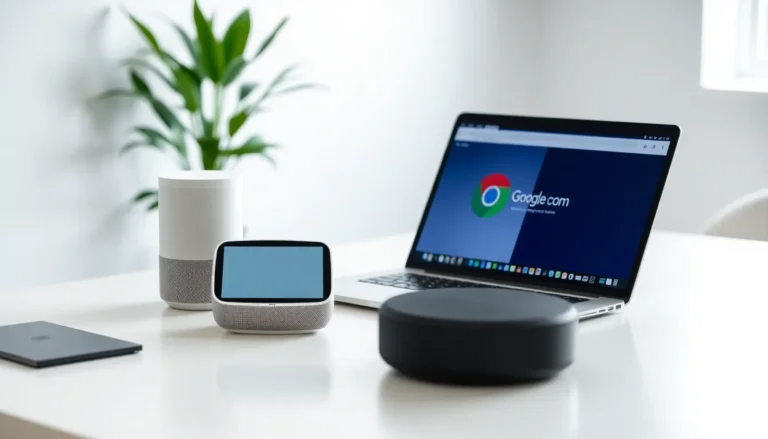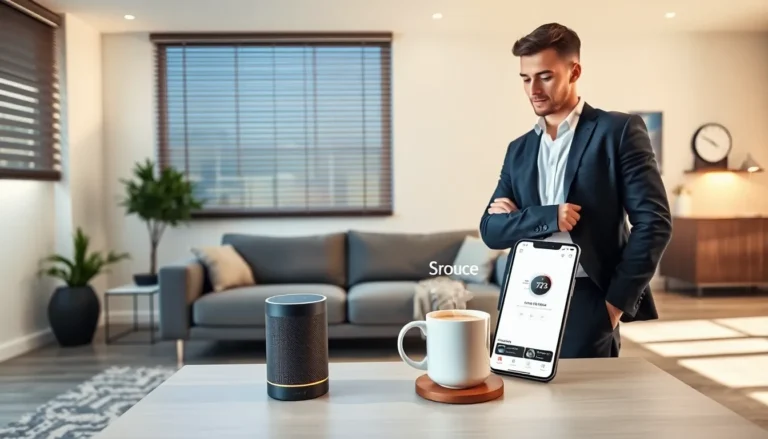Table of Contents
ToggleSmart home technology is transforming the way people live, bringing convenience and efficiency to everyday tasks. With the rise of connected devices, homes are becoming more intelligent, allowing users to control everything from lighting to security systems with just a few taps on their smartphones. This shift not only enhances comfort but also promotes energy savings and improved safety.
As technology evolves, several key trends are shaping the smart home landscape. Innovations like voice-activated assistants, advanced security features, and energy-efficient appliances are becoming mainstream, making smart homes more accessible than ever. Understanding these trends can help homeowners make informed decisions about integrating technology into their living spaces, ultimately creating a more connected and efficient home environment.
Overview of Smart Home Technology Trends
Smart home technology trends shape modern living by offering innovative solutions that enhance everyday experiences. Key areas include:
- Voice-Activated Assistants
Voice-activated assistants like Amazon Alexa or Google Assistant streamline interaction with smart devices, enabling voice control for tasks such as lighting, heating, and security systems. Many users appreciate hands-free operation, which increases accessibility and convenience.
- Advanced Security Features
Advanced security systems integrate smart locks, video doorbells, and surveillance cameras, providing homeowners with real-time monitoring and alerts. These systems help boost overall home security, offering peace of mind and reducing the likelihood of break-ins.
- Energy-Efficient Appliances
Energy-efficient appliances, including smart thermostats, lighting systems, and kitchen devices, contribute to lower energy consumption and greater sustainability. Homeowners can monitor and manage energy use remotely, cutting down on utility costs and environmental impact.
- Home Automation Systems
Comprehensive home automation systems unify various smart devices, allowing centralized control through a smartphone app or a central hub. These systems increase overall efficiency, enabling users to schedule and automate daily tasks such as turning lights on or off and adjusting thermostat settings.
- Health and Wellness Integration
Smart home devices increasingly focus on health and wellness, with options like air quality monitors, sleep trackers, and fitness devices. Homeowners benefit from enhanced awareness and control over their indoor environment, fostering healthier living conditions.
- Seamless Connectivity
Seamless connectivity among diverse devices creates a more cohesive smart home ecosystem. Enhanced interoperability standards, such as Matter, are emerging, allowing devices from various manufacturers to work together effortlessly, elevating the user experience and simplifying setup processes.
These trends indicate a shift towards smarter, more integrated living spaces that prioritize usability, security, and efficiency. Understanding these developments aids homeowners in making informed decisions about adopting smart home technology.
Emerging Technologies in Smart Homes

Emerging technologies significantly enhance smart home systems, driving innovation and user experience. These advancements not only improve convenience but also streamline home management.
Artificial Intelligence and Machine Learning
Artificial intelligence (AI) and machine learning (ML) create tailored experiences in smart homes. AI-powered devices learn user preferences and automate routines, adapting to individual habits. Smart thermostats adjust temperature settings based on the homeowner’s schedule, optimizing energy consumption. Security systems utilize AI to identify unusual activity, enhancing safety with real-time alerts. Voice-activated assistants integrate AI for improved natural language processing, allowing for more intuitive interactions with smart devices.
Internet of Things (IoT) Integration
Internet of Things (IoT) integration connects various home devices, fostering seamless communication and control. IoT devices include smart bulbs, thermostats, and appliances that interact through a centralized hub. This connectivity simplifies automation, allowing users to set schedules and monitor consumption from a single application. For instance, smart irrigation systems adjust watering schedules based on weather forecasts, promoting water conservation. Enhanced interoperability among devices streamlines user experience, ensuring a cohesive and efficient smart home environment.
Popular Smart Home Devices
Smart home devices enhance convenience, security, and energy efficiency. Key devices transforming living spaces include smart security systems and smart thermostats.
Smart Security Systems
Smart security systems combine advanced technology with ease of use. Features include:
- Remote Monitoring: Users access live video feeds from cameras through smartphones or tablets. This capability allows for real-time surveillance of home properties.
- Motion Detection: Sensors trigger alerts when movement is detected, increasing awareness of potential intrusions. Notifications send instantly to users to ensure prompt reactions.
- Smart Locks: Keyless entry systems enable users to lock or unlock doors remotely. They offer secure access control while eliminating the need for physical keys.
- Video Doorbells: These devices allow users to see and speak to visitors without opening the door. They provide enhanced security and convenience, integrating seamlessly with other smart devices.
Smart Thermostats
- Learning Behavior: Many smart thermostats learn user schedules and automatically adjust settings accordingly. This feature promotes energy efficiency by reducing heating or cooling when no one is home.
- Remote Control: Users can control their home temperature from anywhere via smartphones. This remote access ensures comfort upon arrival and prevents unnecessary energy consumption.
- Energy Reports: These devices provide insights into energy usage patterns. They help users understand consumption, enabling them to make informed decisions about energy savings.
- Integration with Other Devices: Smart thermostats often integrate with other smart home systems, such as lighting and security. This interconnectivity allows for holistic home automation, maximizing energy efficiency and user convenience.
Benefits of Smart Home Technology
Smart home technology offers numerous benefits, significantly improving daily life quality through enhancements in energy efficiency and security.
Energy Efficiency
Smart home devices optimize energy consumption, reducing utility bills and environmental impact. Smart thermostats adjust heating and cooling automatically, learning occupants’ schedules to maintain comfort while minimizing energy use. Energy-efficient appliances, such as smart refrigerators and washers, operate during off-peak hours to lower energy costs. Furthermore, smart lighting systems allow users to set schedules and control lighting remotely, ensuring lights are off when not needed. Studies indicate that homes utilizing smart technology can see energy savings of up to 30% annually.
Enhanced Security
Enhanced security represents a significant advantage of smart home technology. Smart security systems offer real-time monitoring through cameras, alerts, and mobile app integrations, enabling users to view their homes from anywhere. Motion sensors can detect intrusions and trigger alarms or alerts promptly. Smart locks provide keyless entry and remote locking capabilities, enhancing access control and security. According to research, homes equipped with smart security features experience up to 50% fewer break-ins compared to traditional homes.
Challenges and Considerations
Smart home technology faces challenges that homeowners must consider. These challenges include privacy concerns and compatibility issues affecting the overall user experience.
Privacy Concerns
Privacy concerns pose significant challenges in smart home technology. Connected devices often collect personal data to function effectively, raising questions about data security. Studies show that 58% of users worry about unauthorized access to their personal information from smart devices. Manufacturers must implement strong encryption and clear privacy policies to safeguard user data. Users should regularly update device software and review privacy settings to enhance security.
Compatibility Issues
Compatibility issues create obstacles for smart home integration. Many devices operate on different protocols, leading to difficulties in unified control. Research indicates that nearly 40% of consumers experience frustration due to incompatible devices in their smart home setups. Homeowners should prioritize devices that support common standards like Zigbee or Z-Wave, ensuring seamless connectivity. Selecting a comprehensive home automation system can also mitigate compatibility challenges, providing a more cohesive user experience.
Future Perspectives of Smart Home Technology
Advanced technologies are shaping the future of smart home technology, ensuring continuous evolution and innovation. Adoption of artificial intelligence (AI) and machine learning (ML) will further personalize user experiences. AI-driven platforms anticipate user needs by analyzing behavior patterns, leading to enhanced automation and convenience.
Integration of 5G networks will significantly improve smart home connectivity. Improved bandwidth and lower latency will enable instant communication between devices, reducing delays in response times. This advancement fosters seamless automation across various smart devices, facilitating real-time data exchange.
Increased focus on sustainability will drive demand for energy-efficient smart devices. Future smart homes will feature devices that optimize power usage, reducing environmental impact while lowering utility costs. Technologies such as smart lighting and energy management systems will empower homeowners to monitor and adjust energy consumption effectively.
Health and wellness technology will become more prevalent in smart homes. Devices that monitor air quality, temperature, and humidity will promote healthier indoor environments. Homeowners will increasingly adopt tools that assess physical activity and provide insights on wellness, enhancing quality of life.
Interoperability among devices will gain importance as smart home ecosystems become more complex. Collaborative platforms will enable devices from various manufacturers to communicate and work together seamlessly. This development will streamline user experience and reduce frustration associated with compatibility issues.
Privacy and security solutions will evolve to address growing concerns. As smart homes collect vast amounts of personal data, manufacturers will prioritize robust security measures. Encryption and advanced authentication methods will become standard features to protect user information.
Smart home technology will also expand its role in emergency preparedness. Future systems will provide advanced alerts and automated responses to threats, such as fire or carbon monoxide detection. This proactive approach to safety will create more secure home environments.
Innovative financial models may change how consumers access smart home technologies. Subscription-based services might provide homeowners with affordable options to integrate cutting-edge devices without significant upfront costs. This shift could make smart technology accessible to a broader audience.
Overall, the future of smart home technology looks promising, with significant advancements on the horizon that enhance convenience, security, and sustainability.
Smart home technology is reshaping how individuals live and interact with their environments. As trends continue to evolve, homeowners have more opportunities to enhance convenience and security while promoting energy efficiency. The integration of AI and IoT is paving the way for smarter living spaces that adapt to user needs.
Challenges like privacy concerns and compatibility issues remain, but awareness and proactive measures can help mitigate these risks. Looking ahead, advancements in connectivity and sustainability will drive further innovation, making smart homes more accessible and beneficial for everyone. Embracing these changes will not only improve daily living but also contribute to a more connected and efficient future.







